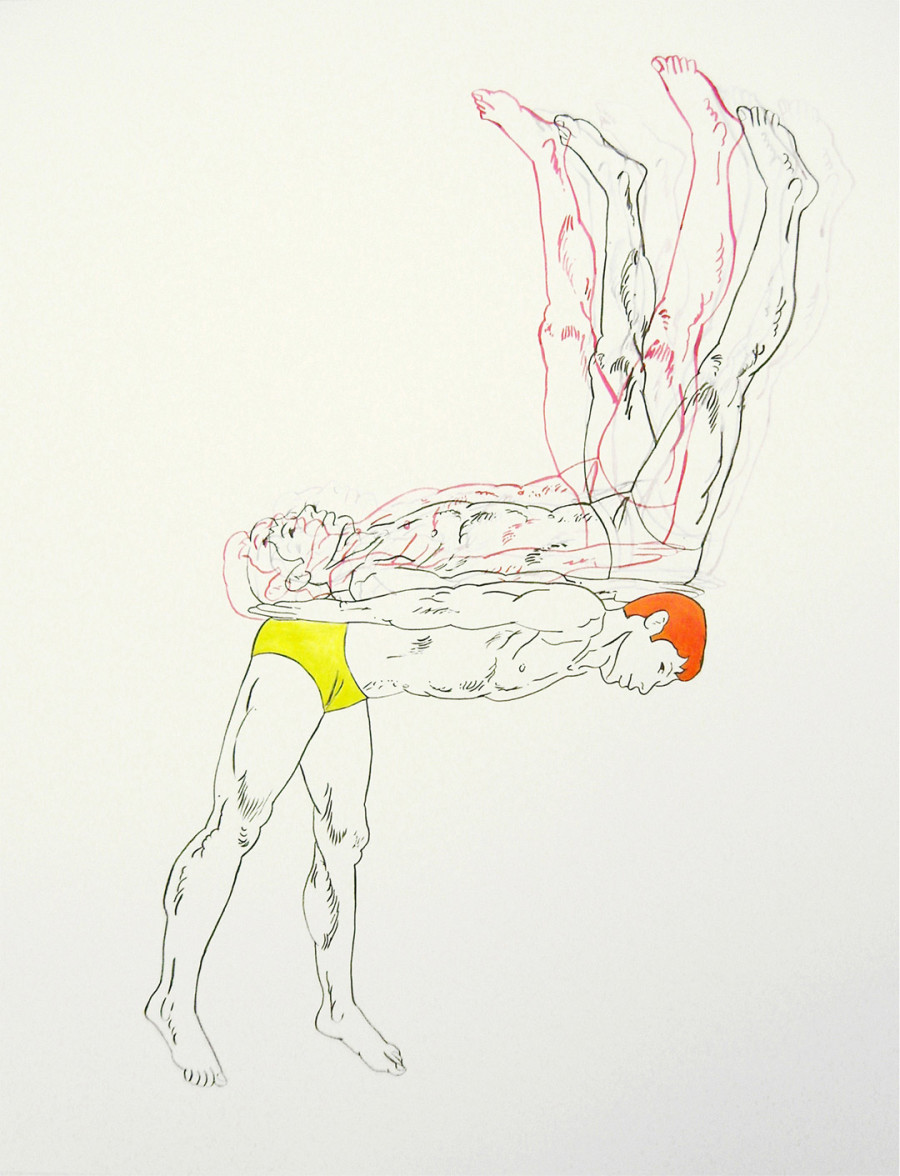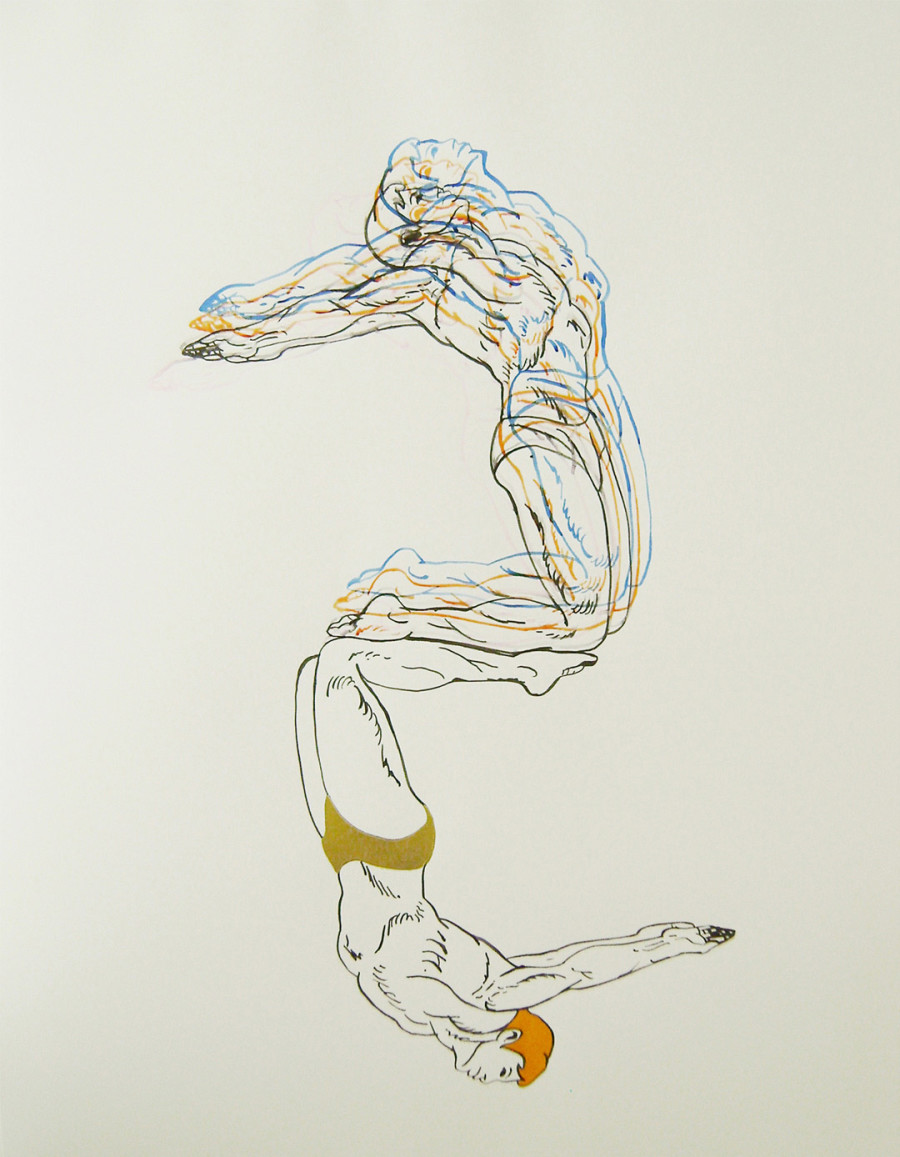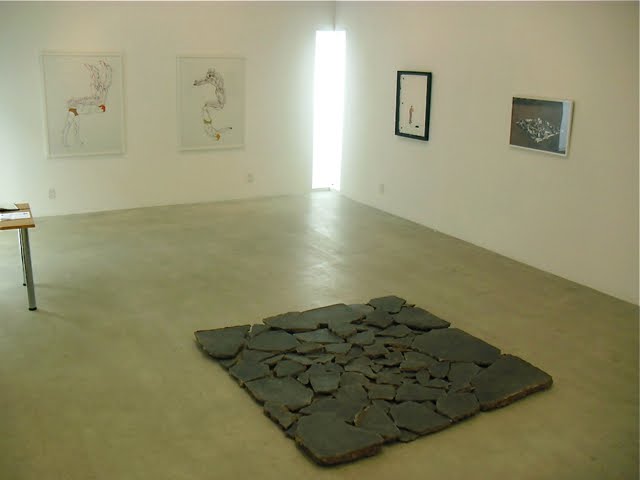CONFES(S)ION(E)S @JAUS
El trabajo de Mely Barragán —frecuentemente asociado con desconfiable rapidez a los intereses de género y el arte feminista— hace de la delgada línea del dibujo que dispone sobre el vacío a sus hombres duplicados, tono y timbre discursivo que anima y subvierte su propuesta estética y conceptual. La representación esquemática, pulcra y atexturizada de los cuerpos de papel que en estas obras reproduce entintados del diseño y visualidad del cuerpo gráfico perfecto en las revistas de mediados del siglo XX evidencian con aparente sencillez una fragilidad que intenta esconderse sobre el dibujo no sólo en la imagen sino incluso de ella. La elección técnica de su obra en perfecto equilibrio y resonancia con la apuesta sígnica de los delicados cuerpos de Barragán convierte a estos tambaleantes narcisos en inquietantes reflexiones-en-refracción sobre el resquebrajamiento inevitable e inherente a toda construcción simbólica saturada de sí. El tremor de sus cuerpos dobles susurra con atronadora claridad el desvelo de la condición humana cuando más expuesta, no en la desnudez sino en la pretensión por alisar sus contornos y enmascarar el resto de su singularidad.
The work of mely barragán—often hastily and presumptuously associated with issues of gender and traditional feminist art—generates a discursive tone and timbre which animates and subverts the aesthetic and conceptual proposal of her duplicated men by rendering fine lines over an empty surface. with this schematic, meticulous and texture-less representation of paper bodies which comprise the works he man i and ii, barragán reproduces design prints and images from idealized magazine illustrations from the mid-20th century; demonstrating with apparent simplicity, the fragility which tries to hide itself not only in the image, but even from the artists herself.
the technical decisions operate under perfect equilibrium and resonance with the semiotic tactics of barragán’s unsettlingly fragile bodies. the artist converts these staggering narcissists into suggestive reflections/refractions concerned with the fracturing which is inherent and inevitable in this over-saturated and symbolic construct. the tremor of their doubled bodies whispers with thundering clarity the un-veiled human condition when it is most exposed–not in its nakedness–but in its endeavor to soften its contours and disguise that which still remains of its singularity.
Marcela Quiroz, 2010
http://falladecortante.blogspot.mx/2010_07_26_archive.html
http://www.jausart.com/default2.asp
- From the man and his series I
- From the man and his series II
confes(s)ion(e)s
6 Artists Working In Tijuana
Featuring Works By: Mely Barragán, Miguel Fernández, Hugo Lugo, Mayra Huerta, Daniel Ruanova, Shinpei Takeda
Opens Friday July 23 6:30-9:30p.m.
Curated by Marcela Quiroz
“Sharing a secret isn’t knowing it or breaking its promise, it is sharing something ignored: nothing known, nothing that can be determined.” ~J. DERRIDA
In one of her least know essays, Spanish philosopher, María Zambrano makes an intriguing commentary regarding artistic practice. Discarding the useless attempt at paraphrasing her words – having the absolute need to have the author’s unadulterated voice read/heard – I transcribe the passage that will guide this brief reflection: “A confession searches for, not a virtual time, but a real one; thus, not daring to settle for a virtual temporality, it stands still precisely at that place where the real time is to take place. This is the time that can’t be transcribed; a time that cannot be captured, it is the unity of life that no longer needs to be expressed. That is why all art possesses some deviated form of confession, sharing, at times, the same objectives as confession, recreating itself as it unfolds, and detains and spends time as if it were a supreme human luxury.”
Let us walk by Zambrano’s side for a moment, and consider her reflections as a pretext for examining the confessions that—already encapsulated—pervade in the works which comprise this exhibition. Let’s talk about that temporality which escapes completely from discursive approaches; a temporality waiting as a promised threshold to be wandered in the somewhat uncanny spatiality the work of art appears to offer. For, according to Zambrano, a confession does not exist in language, rather it happens actively while it inhabits and engenders the act of speech. This is why those who speak and those who hear a confession participate in the complicity that beholds this uncertain temporality that exists in anticipation of the continuity of time. As if the time that hadn’t (still) been spoken from which a confession is nurtured had carried within itself enough beheld strength—existing as a (de)historicized wound—to be able to situate the confessed secret in a spatiality of infinite potential.
Assuming the validity of this active present that Zambrano claims in relation to a confession, the realization of an irreducible subject could be found in its temporality. This fractured subject in its shattered condition gives of itself completely, and negates the relinquishment of being. For life needs to express itself beyond reason and imposed orders. With all its urgency, it is important to understand that a confession does not participate in an impulsive manner that places itself at risk. Any confession takes place within the realm of defeat. Therefore, the word which names it connotes the silence of that which has been (until now) kept unsaid; that which now runs away from itself. This is the reason why he who confesses has the possibility of constructing a recreation of time rescued from a past that (until then) hadn’t really belonged to him, a past that had been ‘other’.
The works in this exhibition wander the proximities of this confessed temporality searching to find that unity of life which would no longer need for words. In each of them exists something that has been already spoken, so the work of art becomes a means of perpetual disclosure of its needs. They interact in this almost-present temporal space, sharing with others who listen and receive its fragility. In spite of their ‘non-confessable’ nature, these works openly and nakedly share with the viewer textures that reveal themselves in their material renderings. Based on the assumption that there exists a ruptured yet undisclosed reality, a reality which remains obscured at the verge of confession, this exhibition confesses itself by reuniting works through the boundaries of this hidden reality—sharing in its (still) silenced origin the same small distance that exists between its (in)visible layers. Having found among the artists selected a common resonance in the urge to transform the irreducible category of that which calls itself “the truth” into a genre in crisis that needs to confess its downfalls and failures; this curatorial proposal acknowledges life when its present reality is distant even from the possibility of recognizing its own contours.
marcela quiroz luna
curator




Discussion Closed